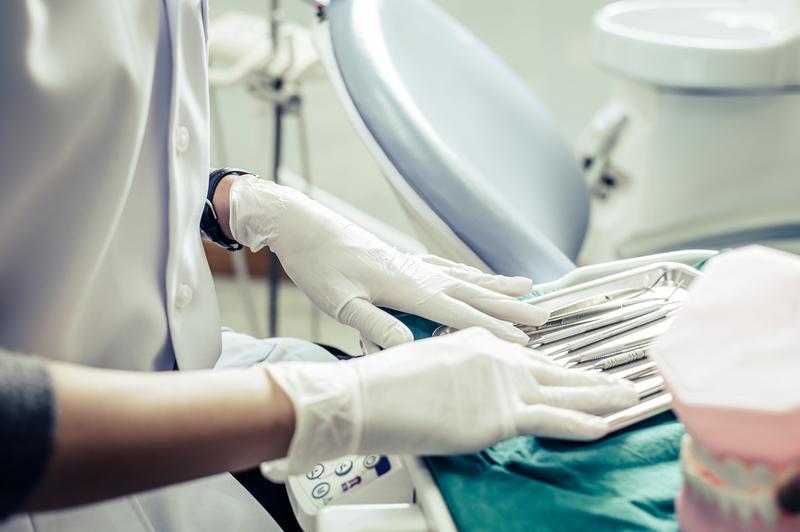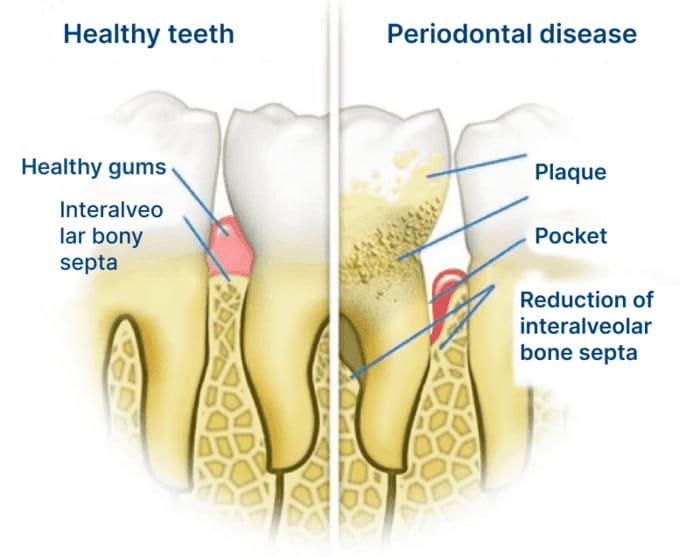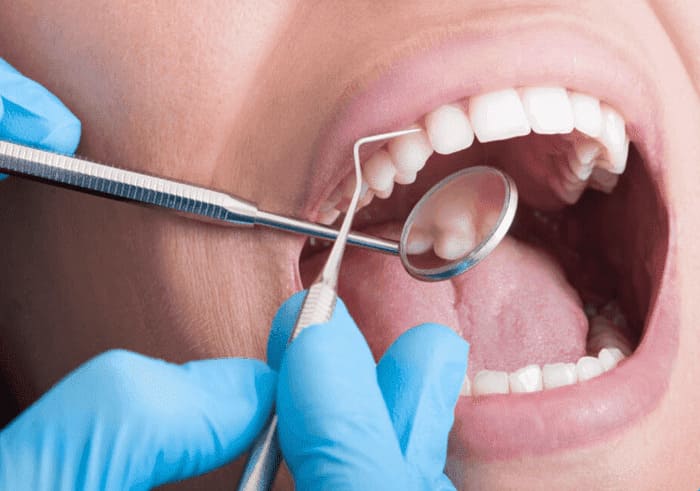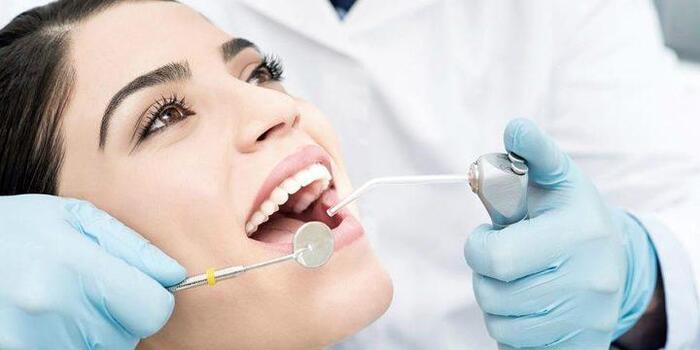Treatment of Periodontal Disease: Modern Methods

Contents:
Periodontal disease is a chronic disease of the tissues surrounding the tooth (gums, bone, ligaments, and cementum). According to WHO estimates, half of the world’s population, approximately 3.5 billion people, suffer from periodontal disease. Therefore, timely and correct treatment is essential.

The leading cause of the disease is the nutrition disorder of periodontal tissues. It can be caused by:
- hormonal disorders (including diabetes);
- metabolic disorders;
- gastrointestinal problems, autoimmune, neurological diseases;
- weak immune system;
- poor nutrition (lack of fluorine, vitamins, micronutrients);
- bad habits (among smokers, the number of patients with periodontal disease reaches 90%);
- poor oral hygiene;
- cavities, bite disorders, and dental diseases.
Taking care of your health and seeking medical help in time is necessary.

Stages of periodontal disease
Periodontal disease is an inflammatory disease that destroys the periodontal tissue and leads to tooth loss. The disease has three stages. The disease’s onset to tooth loss takes several years, sometimes up to 20 years. This period depends on the timeliness of treatment, individual characteristics of the organism, availability, and effectiveness of treatment.
First stage
It is accompanied by swollen, red, and bleeding gums. There is a strong foul-breath odour. Many patients ignore the symptoms and do not treat the disease at this stage.
Second stage
It has more pronounced symptoms. The necks of the teeth are exposed, and deep gum pockets are formed. On X-rays, a significant loss of bone tissue is visible. Teeth become mobile, can shift, and rotate around their axis.
Third stage
Bone tissue is destroyed, and the teeth are held only by soft tissue. The mucous membrane of the gums becomes red or, conversely, pale, livid. Constant inflammation and purulent processes occur. The elements of the tooth row are mobile and strongly displaced, and the bite is influenced. As a result, there is a loss of teeth.
Modern dentistry treats periodontal disease at any stage of the disease. The methods used depend on the degree of tissue damage.
At the initial stage, professional oral hygiene, applications of medicines, vitamins, rinses, irrigations, and massage helps to stop the disease.
In the second stage, injections and medications are prescribed.
In the third stage, splinting, bite correction, gingivectomy, and dentures are used. It is often necessary to treat diseases that cause periodontal disease (diabetes, circulatory system diseases, autoimmune diseases).
Each patient’s rate of disease development is individual. It depends on the general condition of the organism, concomitant diseases, bad habits, oral hygiene, lifestyle, and diet.
The disease can develop for years or reach 2-3 stages in a few months. The course of periodontal disease is accelerated in the presence of concomitant diseases such as diabetes mellitus, thyroid pathology, and pathology of GI organs. A dentist-periodontist will help to make an accurate diagnosis, determine the stage of the disease and the degree of tissue damage, and choose a treatment method.
Prevention of periodontal disease allows you to control the disease development. Practicing good oral hygiene, giving up bad habits, treating dental diseases on time, and regularly visiting the dentist for examination and professional teeth cleaning are necessary.

At the Clinic of Aesthetic Dentistry, our experienced specialists treat periodontal disease using the latest techniques, modern equipment, and materials. Periodontists of the medical centre manage to achieve excellent results in fighting gum diseases.
Methods of Periodontal Disease Treatment
Treatment of periodontal disease begins with full diagnostics, determining the causes of the disease, its stage, and the state of periodontal tissues.
We use radiography, CT, laboratory tests, oral cavity examination, reoparodontography, capillaroscopy, pH-metry, and other tests for diagnostics.
The following treatments are used to control periodontal disease:
- Conservative (therapeutic):
- Professional oral hygiene (removal of plaque and tartar, polishing the surface of the teeth).
- Medications (oral medications, applications to the gums, injections of drugs that inhibit the development of pathogenic microflora, promote tissue regeneration, antibacterial and antiseptic treatment of the gums).
- Physiotherapeutic (galvanotherapy, ultrasound action, massage, diathermy, vacuum).
- Plasma therapy (treatment with preparations based on the patient’s blood plasma).
- Surgical:
- Curettage (removal of tartar from periodontal pockets).
- Gingivectomy (resectioning a portion of the gingiva to eliminate periodontal pockets).
- Flap surgeries (restoration of the gingival margin).
- Orthopaedic:
- Splinting (strengthening of mobile teeth).
- Prosthetics (restoring the function and aesthetics of lost teeth with prostheses).
Modern treatment of periodontal disease is carried out using laser technology. This technique reduces the painfulness of operations and allows them to do without anaesthesia.

During the first stage of the disease, treatment is carried out using therapeutic methods. The earlier the patient consults a doctor, the faster, easier, and more effective the treatment.
At later stages, surgical and orthopaedic methods are added to conservative methods. Treatment takes place over a long period.
After recovery, the patient must follow the doctor’s recommendations, constantly supervise the specialist to eliminate the risk of relapses, and carefully monitor oral hygiene.
The Clinic of Aesthetic Dentistry uses the latest technologies and modern equipment to treat periodontal disease. The medical centre uses neodymium laser, plasma therapy, the latest medicines, deep scaling, and curettage.
New methods of therapy and surgery guarantee getting rid of periodontal disease at any stage of the disease, restoring the functions of teeth and a beautiful smile.
Importance of Timely Treatment
Modern treatment methods of periodontal disease in the early stages can help eliminate the disease, strengthen the gums, and prevent the destruction of periodontium. It is essential at the first signs of the disease to contact a dentist, diagnose the disease, and identify the cause of its development.
The disease develops in the bone tissue, which is invisible without special diagnostic methods (X-ray). The disease does not have a pronounced pain syndrome at an early stage. All this leads to patients turning to the dentist, often at the 2-3 stage of periodontal disease.
Patients who self-medicate and do not consult a doctor waste time and risk complications. Not waiting for a positive result, they get to see a specialist already at the 2-3 stage of the disease.
If the disease is neglected, the treatment will be more complicated and take longer. Even at the third stage, it is possible to stop the disease, avoid tooth loss, improve the condition of tissues, and carry out their regeneration.
To successfully fight the disease, the patient must clearly follow the recommendations of the dentist:
- practice good oral hygiene;
- undergo the prescribed courses of treatment;
- give up bad habits;
- start a healthy diet.

A healthy person should have at least two preventive check-ups at the dentist’s at least twice a year and have teeth professionally cleaned to remove dental deposits. This reduces the risk of gum disease.
Specialists of the Clinic of Aesthetic Dentistry have extensive experience treating periodontal disease. They apply modern therapy methods, surgery, and prosthetics to restore the patient’s perfect smile. They carry out the treatment using the latest equipment and materials.

